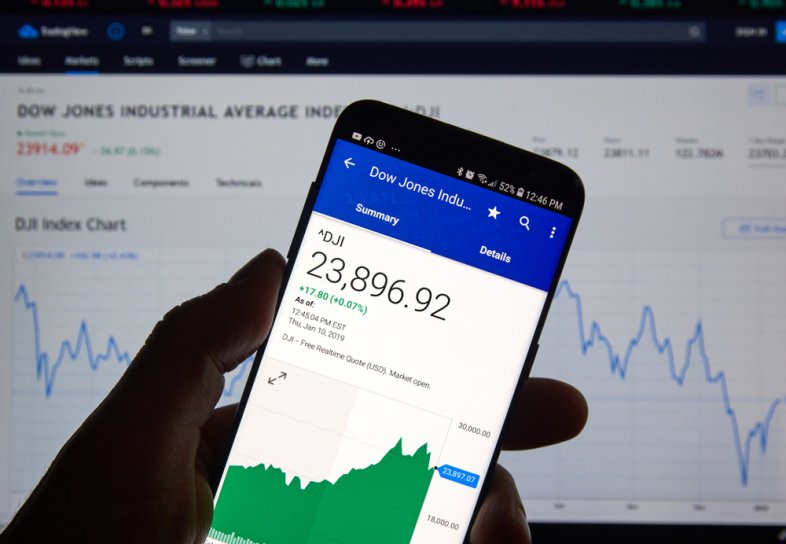How to Invest in the Dow Jones Industrial Average

When people talk about the stock market, they often reference the Dow Jones Industrial Average (DJIA).
While it’s a popular term used by investors, you may not realize why it’s important and how it can help shape your own investment strategy.
The DJIA is an index made up of 30 of the biggest and most well-known companies in the country. Morningstar reported that it has a total return of 8.35% over the past ten years.
If you want to incorporate the index into your portfolio, here’s how to invest in DJIA.
What is the Dow Jones Industrial Average?
The Dow Jones Industrial Average (DJIA) is an index, meaning it’s an unmanaged group of securities whose performance is used as a benchmark.
The DJIA has been around since 1928. It’s a price-weighted average of 30 blue-chip stocks — shares of large, well-known companies with a proven history of growth — that are typically leaders in their industries.
Companies that are part of DIJA include big names such as:
- Walt Disney Company (DIS)
- Wal-Mart Incorporated (WMT)
- Johnson & Johnson (JNJ)
- The Boeing Company (BA)
- The Coca-Cola Company (KO)
Because the DJIA is only made up of 30 companies, it’s very targeted and narrow in focus. Its performance may not be indicative of the stock market’s performance as a whole, but you’ll see its gains or losses widely reported.
Why Would You Invest in the DJIA?
Because the DJIA is an index of blue-chip stocks, each of the companies in it is a proven performer with a long-standing track record of growth.
While there are no guarantees with investments, and you always risk losing money, all 30 companies have strong reputations and financial details, making them relatively sound investment choices.
DJIA vs. the S&P 500
When reporting the stock market’s daily performance, experts usually reference either the DJIA or the S&P 500 Index.
While the DJIA is a very targeted index of just 30 companies, the S&P 500 Index is much broader. Despite its name, it’s actually an index that tracks the performance of 505 of the largest publicly-traded companies in the country.
In addition, the DJIA is price-weighted, meaning the value of the index is based on the prices of the 30 members.
By contrast, the S&P 500 Index is market-weighted. The largest companies, such as Apple and Microsoft, make up a larger percentage of the overall index and have a bigger impact on the index’s movements.
Because it has a broader range of companies, the S&P 500 Index is typically considered a better reflection of the stock market’s overall performance. However, both indexes are good indicators of the market’s general health.
Whether you decide to invest in the DJIA or the S&P 500 Index, your investments in either index can be part of your long-term investment strategy.
How to invest in DJIA
The DJIA is simply an index that reflects the average price of the 30 stocks within it.
As such, it isn’t possible to buy shares of DJIA itself.
However, there are ways to invest your money in investment products that mirror the DJIA index:
Individual stocks
If you have an investment account, you can buy shares from each of the companies that make up the DJIA.
As of May 17, 2020, the following companies are part of DJIA:
- 3M (MMM)
- American Express (AXP)
- Apple (AAPL)
- Boeing (BA)
- Caterpillar (CAT)
- Chevron (CVX)
- Cisco (CSCO)
- Disney (DIS)
- Dow Chemical (DOW)
- Exxon Mobil (XOM)
- Goldman Sachs (GS)
- Home Depot (HD)
- IBM (IBM)
- Intel (INTC)
- Johnson & Johnson (JNJ)
- JPMorgan Chase (JPM)
- McDonald’s (MCD)
- Merck (MRK)
- Microsoft (MSFT)
- Nike (NKE)
- Pfizer (PFE)
- Procter & Gamble (PG)
- Travelers Companies Inc (TRV)
- United Technologies (UTX)
- UnitedHealth (UNH)
- Verizon (VZ)
- Visa (V)
- Wal-Mart (WMT)
- Walgreens (WBA)
However, there are some downsides to this approach.
Each share of an individual stock within the DJIA can be quite expensive; a single share can cost over $300, making it difficult for new investors to get started.
And, the companies included in the DJIA index can change over time, so you may have to adjust your investments as companies are added and removed.
Mutual funds
Instead of buying shares of a single company, mutual funds allow you to diversify your portfolio. You pool your cash with other investors to buy batches of securities.
There’s less risk since you can invest in hundreds or even thousands of securities at once. If any one security performs poorly, the others may be able to offset the risk.
A popular mutual fund of investors who want to follow DJIA is the Rydex Dow Jones Industrial Average Fund (RYDHX). It invests at least 80% of its net assets in securities of companies in the underlying index.
Exchange-traded funds
With an exchange-traded fund, you can invest in dozens or hundreds of securities at once. If you invest in an ETF based on DJIA, you can diversify your investment across all of the companies in the index.
The most popular option is the SPDR Dow Jones Industrial Average ETF (DIA). This fund is designed to provide results that correspond to the DJIA index. The portfolio of stocks corresponds to the DJIA portfolio.
Start investing in DJIA in 3 steps
Now that you know how to invest in DJIA, you can start investing your money in just three simple steps:
1. Select what type of investments you want to make
Think about what type of investment makes the most sense for you:
- Individual stocks: If you want to build your own portfolio by picking and choosing select companies and are comfortable with the added risk, buying individual shares in one company may be the best option for you.
- Mutual funds: If you want instant diversification — and don’t mind that mutual funds can have a higher expense ratio and can only be traded once per day — mutual funds are likely a better choice for you.
- ETFs: ETFs combine the benefits of stocks and mutual funds. You get the diversification of mutual funds, but ETF trades can be completed throughout the day, giving you more flexibility with your trading strategy.
2. Invest in Dow companies
Once you’ve decided what investment types make the most sense for you, you can move forward with investing your money. To get started, you’ll need to do one of the following:
- Purchase shares directly from the company: With many large, publicly-traded companies, you can purchase individual shares directly from the company without having to go through a brokerage firm. For example, you can buy shares through Disney’s direct stock purchase program by completing an enrollment form and making an initial cash investment.
- Open a brokerage or IRA account: If you plan on buying shares from multiple companies or want to invest in mutual funds or ETFs, you’ll need to open a brokerage account or IRA account. When looking for a brokerage firm, make sure you consider factors like minimum required investments and fees.
3. Buy individuals shares, mutual funds, or ETFs
If you opted for a brokerage account or an IRA rather than a direct stock purchase, you could buy shares, mutual funds, or ETFs through your new account.
If you’re still undecided about what investments make the most sense for you, consider these key points.
- Stocks: Stocks can be bought and sold multiple times throughout the day.
- Mutual funds: Mutual funds can only be traded once per day after the market closes.
- ETFs: Like stocks, ETFs can be traded multiple times during the day.
ETFs and stocks also have limits and stop orders. With a limit order, you can commit to buy or sell a share when it reaches a certain price.
With a stop order, once the price of a security reaches a specific price, the stock is bought or sold. Having the ability to put these orders in place gives you more control.
If you’re new to investing, here are four investment tips for twenty-somethings to help you get started.

